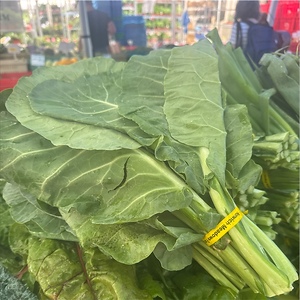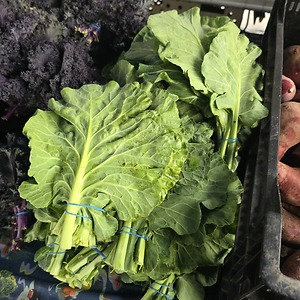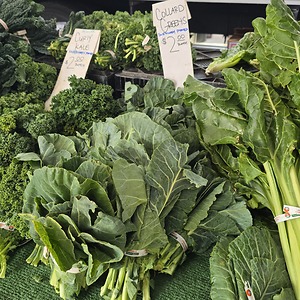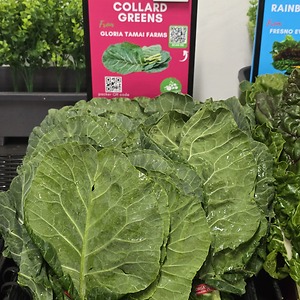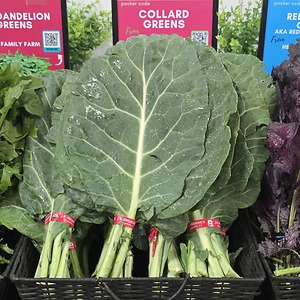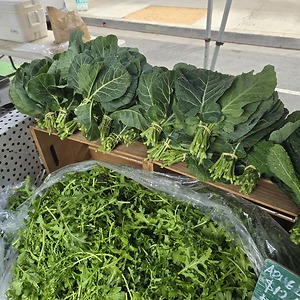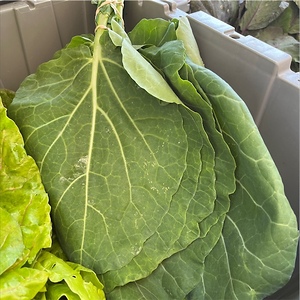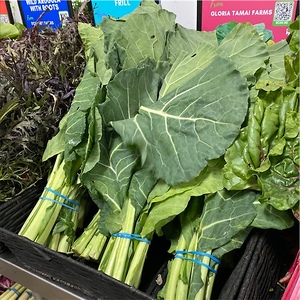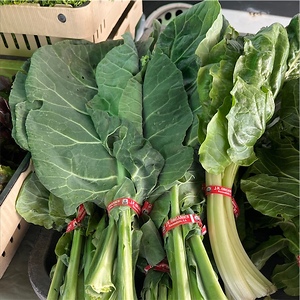


Collard Greens
Estimated Inventory, 24 ct : 3.52
This item was last sold on : 07/19/25
Description/Taste
Collard greens vary in size and shape, depending on the specific variety, and are generally broad, flat, and upright leaves that grow in a rosette or overlapping pattern. Most types of Collard greens feature leaves averaging 7 to 15 centimeters in diameter and are attached to thick, fleshy, and sometimes fibrous stems reaching 60 to 120 centimeters in height. The leaves showcase green, grey-green, yellow-green, to blue-green hues and are sometimes flushed with patches of red or purple, varying with cultivar and growing conditions. Collard green leaves also bear prominent veining that extends through the entire leaf and may be slightly raised on the leaf’s underside. The top surface of the leaf is smooth, pliable, thick, and waxy with a faint leathery feel. The leaf’s edges can be wavy or straight, and some varieties may be more crinkled while others are smooth. Collard greens are chewy and semi-tough when raw and have a subtle freshness to their aroma and flavor. Raw Collard greens are earthy, grassy, vegetal, subtly sweet, tangy, and slightly bitter. Some varieties may be milder than others. Once cooked, the greens soften and mellow in overall flavor, becoming savory and less bitter.
Seasons/Availability
Collard greens are available year-round, with a peak season in the late winter through early spring.
Current Facts
Collard greens, botanically classified as Brassica oleracea var. viridis, are a widespread species belonging to the Brassicaceae family. The dark leafy greens are part of an ancient species that has been growing wild for thousands of years and have since expanded worldwide as a culinary crop. There are many types of Collard greens due to natural variation in selective breeding, and the main types include heading collards, tree or run-up collards, cabbage collards, and curly leaf collards. Most varieties seen in commercial markets are taken from tree or run-up collards, a plant that forms an elongated stem topped with large, broad leaves, resembling a short, small tree. Regardless of the type, Collard greens are easy to grow and frost tolerant, sometimes improving in flavor after periods of cold temperatures. The leaves can be harvested at any stage of maturity and are known worldwide as a nutritious green. During peak season, Collard greens are grown in home gardens and purchased through local markets for raw and cooked culinary preparations. The greens are favored for their nutritional properties, hearty nature, and versatility and are utilized by chefs and home cooks worldwide.
Nutritional Value
Collard greens are a source of fiber to stimulate and cleanse the digestive tract, calcium to support bones and teeth, and omega-3 fatty acids, which are known for their anti-inflammatory properties. The dark leafy greens also provide vitamins A, C, E, and K to strengthen the immune system, maintain healthy organ functions, guard the cells against the damage caused by free radicals, and aid the body in faster wound healing. Beyond vitamins, Collard greens contain minerals like potassium, magnesium, iron, copper, phosphorus, and manganese. Potassium helps the body balance fluid levels, iron develops the protein hemoglobin for oxygen transport through the bloodstream, and copper assists the body in maintaining connective tissues.
Applications
Collard greens have a vegetal, earthy, green, and subtly bitter flavor suited for fresh and cooked preparations. It is recommended to thoroughly wash the leaves as they contain dirt and grit, and tough portions should be trimmed before use. Collard greens can be eaten raw or added to salads and slaws. They are also used as a wrap or occasionally blended into smoothies. Younger and more tender leaves are the preferred greens for fresh preparations, and mature leaves are typically cooked to soften their texture and flavor. Collard greens can be added to soups, stews, and casseroles or braised with turnips as a side dish. One of the most well-known recipes in the United States is traditionally served on New Year’s Day. It is said eating cooked Collard greens with black-eyed peas, a dish known as Hoppin’ John, is thought to bring good luck in the year to come. Collard greens are also cooked worldwide in omelets, pasta, and other braised dishes. The earthy, vegetal nature of the leaves complements recipes with acidic, salty, and sweet ingredients to help balance flavors, including recipes such as caldo verde, a rich soup in Portugal. Collard greens are also used in dishes throughout Africa, including sukuma wiki, which is sauteed greens with tomatoes, onions, and spices, and are sometimes blanched and fried with meat and tomatoes into a stew. In South America, Collard greens are used in the national dish of Brazil called feijoada, and the leaves are also sauteed in butter and olive oil. Collard greens are also frequently seen in Kashmiri recipes in soups and rice dishes. Collard greens pair well with herbs such as fenugreek, fennel, coriander, and bay leaves, meats including poultry, pork, and beef, potatoes, tomatoes, and flavorings like molasses, vinegar, and Worcestershire sauce. Whole, unwashed leaves will last 1 to 3 days when wrapped in a towel and stored in the refrigerator. Collard greens can also be blanched and frozen for extended use.
Ethnic/Cultural Info
In the United States, Collard greens have a complex history woven into the story of the transatlantic slave trade during the 16th to 19th centuries. Collard greens were one of the few crops that slaves were permitted to grow, and the dark, leafy greens were used as a vital source of nutrients. Meals for slaves primarily consisted of leftover pieces of meat like ham hocks, and these pieces were combined and slow-cooked with Collard greens and leftover vegetables like turnips. Many of the cooking methods used among the African populations imprisoned in the Southern United States were of African origin, and slow-cooking greens and consuming the savory broth was a traditional, favored practice. As methods for salvaging the food scraps evolved, the broth created from Collard greens was eventually called “potlikker” and was valued as a concentrated source of vitamins. Potlikker became a foundational culinary ingredient in the African American diet and was consumed in many ways, including as a medicinal drink, soaked up with cornbread and eaten, and/or used as the base flavoring in other culinary dishes. African slaves also began preparing Collard greens for slave owners, popularizing the dish throughout the Southern community. Collard greens have remained a culinary staple in the United States, and the historical impact that the greens have had throughout history is still honored and remembered through traditional cooking methods, such as creating potlikker, in the present day.
Geography/History
Collard greens are descendants of a wild species of Brassica oleracea with origins in the Mediterranean and Asia Minor. The wild species has been growing naturally since ancient times and was eventually domesticated into several different types of plants. Early versions of Collard greens were grown in Ancient Greece and Rome, and the species was spread into other parts of Europe and Africa through trade routes. Collard greens were introduced to the New World sometime in the 16th and 17th centuries and were carried by European settlers for planting in gardens. Collard greens ultimately spread throughout both hemispheres to become a globally grown crop, creating many new varieties with different leaf appearances, colors, textures, and flavors. In 2011, Collard greens also became the official state vegetable of South Carolina in the United States of America. Today, Collard greens are commercially produced worldwide and are considered an easy-to-grow, low-cost crop. When in season, the greens are sold through local markets, select retailers, and distributors to chefs and home cooks. They are also grown in home gardens in both hemispheres for individual family use.
Featured Restaurants
Restaurants currently purchasing this product as an ingredient for their menu.
| Ridgeview Health Center | San Diego CA | 858-293-3950 |
| The Glen at Scripps Ranch | San Diego CA | 858-444-8500 |
| Pete's Premade Paleo | San Diego CA | 770-359-8274 |
| Louisiana Purchase | San Diego CA | 619-255-8278 |
| Artifact at Mingei | San Diego CA | 619-846-2164 |
| SIE Culinary Management | San Diego CA | 858-964-8677 |
| Rose Café | Carlsbad CA | 310-399-0711 |
| Lodge at Torrey Pines Main | San Diego CA | 858-453-4420 |
| Encontro North Park | San Diego CA | 310-955-6333 |
| La Costa Resort & Spa Main Kitchen | Carlsbad CA | 760-930-7063 |
| Chef Danielle Sharesse | San Diego CA | 619-892-2178 |
| PFC Fitness Camp | Carlsbad CA | 888-488-8936 |
| San Diego Humane Society | San Diego CA | 619-299-7012 |
Recipe Ideas
Recipes that include Collard Greens. One



